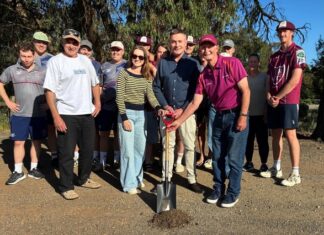BERWICK Fire Brigade was on the move again during the early 1980s.
With support from the council, an alternate site was found at the rear of Buchanan Park on Clyde Road for the training facility.
Using compensation money received from the SR and WSC and countless hours of volunteered members’ time, a new facility was constructed that still serves the brigade today.
Berwick has always been an innovative brigade.
In 1969 it was the first brigade in the district to purchase breathing apparatus and in 1970 received a brand new Austin frontmounted pumper from the CFA.
It also became the home for the region’s spare tanker appliance.
In 1974 the brigade’s competition team travelled to Devonport, Tasmania, and tied for first place in the grand aggregate.
The team had become interstate champions.
The brigade fought two memorable fires in the 1970s, one in February 1973 when a wing of St Michael’s Catholic Primary School in High Street was destroyed by fire, the next in 1975 when Berwick identity Ted Mawdsley died in a house fire in Gloucester Avenue.
Two firemen entered the burning house wearing breathing apparatus and risked their lives in an effort to save Mr Mawdsley.
Berwick Railway Station was destroyed in another major fire in May 1978.
The platform buildings were deliberately set alight and it was only the brigade’s efforts that saved new hitech signalling equipment.
Memories of Ash Wednesday 1983 are firmly etched in the minds of many people, not least the Berwick fire fighters who rallied to the cause on that day.
Initially deployed in the Harkaway area and later Upper Beaconsfield, the brigade members battled fierce fire conditions in an effort to save lives and property.
Their efforts continued over the coming weeks as hot spots were extinguished and recovery efforts got under way.
It was recognised in 1983 that the brigade’s home in Gloucester Avenue had outlived its usefulness and that modern CFA appliances could not be housed in the existing buildings.
The CFA leased land from the railways in Reserve Street and built a modern fourbay engine room station on the site and this was officially opened in March 2004.
At the time the brigade was only issued with a pumper by the CFA and occasionally housed a region spare tanker when one was available.
The brigade members approached the CFA with the idea that if they were to make a capital contribution then the CFA would permanently assign a 4WD tanker to the brigade.
In those days tankers cost around $50,000 and the brigade paid $25,000 to the CFA to secure its new asset.
The new tanker and a new pumper were commissioned at the station opening.
Another of the town’s major fires occurred in December 1984 when the Berwick Football Clubrooms in Buchanan Road were gutted in a late night blaze and much of the club’s memorabilia was lost in the fire.
Fighting the fire was difficult, with pumpers relaying water from Miller Street.
A year later brigade members were part of Campaign Firelight in northeast Victoria.
For weeks members manned the brigade’s tanker in the BrightPorepunkah district and received a commendation for their efforts.
During the 1990s the brigade became more involved in community activities and starred in the Highland Games and Berwick Show tug of war competitions, reigning as champions for several years.
Members became involved in the annual Royal Children’s Hospital Good Friday appeal. Every year since then, they have joined with Narre Warren Fire Brigade to raise many thousands of dollars at the High Street/Clyde Road intersection.
The Anzac Day RSL service was also adopted as a brigade activity and a strong contingent of marchers join exservicemen every year for this remembrance event.
In 1997 Berwick’s tanker made the first of a number of interstate journeys to support NSW colleagues with their major fires.
Members were treated as heroes around Sydney and regional areas as crews assisted weary locals with major fire fighting operations.
In future years the brigade got as far as the Queensland border in its fire fighting travels.
One of Berwick’s major accidents occurred in September 1997 when a garbage truck lost control in the lane behind shops on the north side of High Street.
The truck careered down the lane out of control and collided with several cars causing $200,000 damage.
Berwick Dry Cleaners again features in the brigade’s list of major fires in June 2001, having previously burnt down in High Street in 1955 with one of the most spectacular blazes the district had seen.
The Gloucester Avenue premises were fully alight when the brigade received notification of the fire at the brigade’s monthly meeting. Members were on scene within minutes.
Explosions rocked the building during the height of the blaze.
“Make Pumpers Four” was the call and crews fought the fire from the front and rear, managing to contain it to the premises and minimise damage to adjacent exposures, including the brigade captain’s business offices which backed on to the fire.
Get the latest news to your email inbox FREE!
REGISTER




